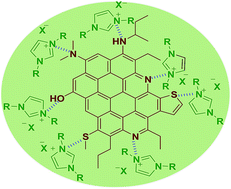Eco-efficient and green method for the enhanced dissolution of aromatic crude oil sludge using ionic liquids†
Abstract
The upstream petroleum industry faces operational and technical problems due to increased deposition of waxes, aromatics and asphaltene from crude oil sludge in oil storage tanks in the form of tank-bottom sludge (TBS). This results in huge production losses, and threatens environmentally safe operation; therefore, safer solutions are needed. In this work, nine aromatic ionic liquids (ILs) are synthesized and tested for the dissolution of TBS with the aid of five solvents, namely, toluene, heptane, decane, ethyl acetate and hexane. The UV absorbance values of the standard solutions (TBS in solvent) are compared with the sample solutions (TBS in solvent + ILs). It is observed that ILs significantly improve the dissolution of TBS in solvents compared with neat solvent alone. Different weight ratios of TBS : ILs (1 : 1, 1 : 0.5 and 1 : 0.1) are considered in this study. Ionic liquids (ILs) based on an imidazolium cation and various anions, such as [Cl]−, [Br]−, [BF4]−, [H2PO4]−, [HSO4]−, and [PF6]−, are considered in this investigation. It is observed that the dissolution of TBS in heptane in the presence of [HMIM]+[Br]− is efficient to a maximum extent of 66% with other solvents showing similar increased solubility effect with various ILs. In the case of hexane, it should be noted that the efficiency of dissolution of TBS goes on decreasing with increasing concentration of TBS in hexane. A hold-time study is also performed with heptane containing ILs and heptanes without ILs to determine the maximum time required for efficient dissolution of TBS. It is observed that the efficiency is increased beyond 66% in the presence of ILs for the dissolution of TBS in heptane, provided that the mixture of solvent and ILs are in contact with the TBS for a prolonged period of 30 days, or even longer as required. FT-IR and 13C-NMR spectral analyses are also performed so as to understand the efficiency of the ILs in the dissolution of TBS in various solvents, and it was observed that there is a decrease in the intensity of the peaks in the spectra of treated TBS with solvents, which is further enhanced by the addition of ILs.


 Please wait while we load your content...
Please wait while we load your content...